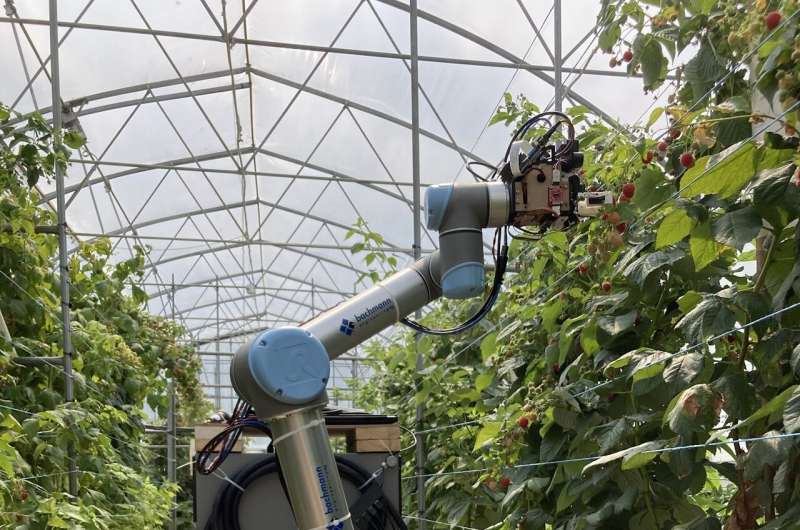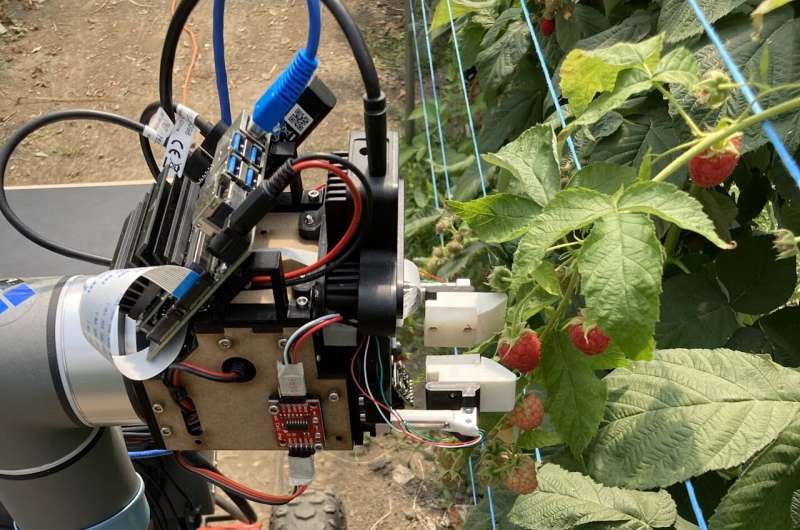June 26, 2023 report
This article has been reviewed according to Science X's editorial process and policies. Editors have highlighted the following attributes while ensuring the content's credibility:
fact-checked
trusted source
proofread
Using fake raspberries to train robots how to pick real ones

A trio of roboticists at CREATE Lab, EPFL, in Switzerland, has designed, built and tested a robot that can pick raspberries. In their project, reported in the journal Communications Engineering, Kai Junge, Catarina Pires and Josie Hughes designed and tested their robot based on a new idea to reduce the cost of designing fruit-picking robots.
Over the past several years, the demand for food has grown with rising population. In response, scientists are looking for ways to produce more food at a reasonable coast. One approach involves using robots instead of humans to perform manual labor, such as picking fruit.
Picking almost any fruit on a large scale is, by its nature, labor intensive and fruit harvesting is considered to be a relatively expensive operation. So scientists have been working toward the use of robots to pick fruit. This has proven to be more difficult for certain crops than others. Picking raspberries, for example, is difficult for a robot as it involves multiple skills. A robot must be able to determine which fruit is ripe and it must be able to pick each one individually without causing any damage to the fragile fruit.
Picking raspberries without causing damage is more difficult than for other fruit because picking involves grasping the fruit around its center, rather than its stem. Squeezing too hard crushes the fruit. Another problem for such specific applications is the huge amount of time involved in field learning and testing. In this new effort, the researchers in Switzerland tried to solve both problems using a new approach—teaching the robots what to do by using artificial plants and fruit. Thus, the work by the team involved designing both a robot and an artificial raspberry plant.
Allowing a robot to learn to pick fruit repeatedly in a test lab, the research team found, is significantly faster and cheaper than doing it in the field. The robot they built uses graspers for picking and cameras and software to identify fruit targets. By practicing multiple times in the lab, the robot grew better at identifying and picking raspberries. The team then moved outside and tested the robots on their raspberry-harvesting skills on real fruit.

The robots turned out to be sub-par compared to humans, picking only 60% of appropriate targets without damage. This compares to approximately 90% for human pickers. The researchers suggest their work thus far proves the process can work and that improvements could likely increase the accuracy to human levels.
More information: Kai Junge et al, Lab2Field transfer of a robotic raspberry harvester enabled by a soft sensorized physical twin, Communications Engineering (2023). DOI: 10.1038/s44172-023-00089-w
© 2023 Science X Network


















